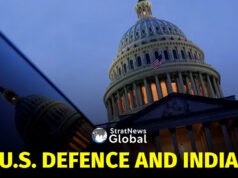Operation Sindoor is still on. And hence from a correctness perspective, there is no “mortem” for doing a post-mortem. However, it is worth analysing who achieved what objectives and therefore who won in the kinetic conflict under Operation Sindoor.
Operation Sindoor was launched on May 7, after the dastardly attack in Pahalgam on Hindu male tourists from India and Nepal on April 22. This attack was perpetrated by Pakistan state’s non-state actors, a euphemism for terrorists. Also, this may sound like an oxymoron: how can non-state actors belong to a state? And this is precisely the ridiculous claim by Pakistan that was called out by the Indian government. The outcome of such a call-out by the Indian government was an unequivocal shift towards viewing an attack by the so called “non-state” actors of Pakistan as an attack from Pakistan itself, which was the unassailable truth.
In response, the Indian government decided to take a measured step of only destroying nine terrorist camps within Pakistan. This military operation took less than 25 minutes to complete on May 7, thereby achieving the military objective of India, which was to communicate that from now on, Pakistan’s state-sponsored violence against India, no matter if the vector used is non-military personnel such as terrorists or any other mechanism, will not be differentiated from violence by Pakistan as a state, and hence the response from India will be a military one.
This is the same paradigm that Israel used as response to Hamas’ terrorist attack on Israeli soil.
So who won the conflict? The question becomes more acute, given the massive propaganda war that was unleashed by Pakistan, which was curiously lapped up by the Western press and governments, as is reflected in the utterances of some heads of state. The answer to the question of who won would be based on who achieved their objectives from the conflict.
Based on the above parameter, India undisputedly achieved its single-minded objective of establishing that it will not differentiate between non-state actors and their handlers. The two will be treated as same and India will not shy away from military escalation as a response to such cross-border terrorism. The message is clear not only to Pakistan but also to the rest of the world.
The conflict also showed that the Indian military is in the right trajectory in terms of its transformation. And though many more years of investment are needed, what has already been achieved has made the Indian defence an even more formidable force.
The conflict also achieved an outcome which was not a stated objective—it put India’s military capabilities at the forefront and established the Indian military as a force to reckon with in the global pecking order. The Indian military is now an even more feared and respected machinery and its technological capabilities well acknowledged. This development has had an unexpected benefit in terms of making Indian-made weapons much sought after globally, propelling their exports.
What is the flip side? The world has woken up to India’s capabilities. The conflict demonstrated that Western- and Chinese-made weapons are ineffective against India’s defensive and offensive capabilities. The initial restrained response from India was viewed as a deficiency of the Indian military, which quickly switched to a full-blown display of military capabilities, decimating Pakistan’s China-supplied air defences, blowing up much of their military assets including those supplied and maintained by the west. Therefore, there is a scramble to now equip Pakistan with deadlier weapons and capabilities. It will also force China and other powers that were involved, such as Turkey, to upgrade their own military capabilities. This further reduces any luxury of time that India had in its journey towards rapid transformation of its military capabilities.
A vector once used cannot be used again in another conflict, as the NSA had once remarked to me. India would now need to institutionalise continuous building of new weapon platforms, weapon systems and weapon paradigms and further accelerate its transformation. The conflict has clearly helped in pushing India’s mighty military-industrial complex to not just modernise but also move towards creating new benchmarks and weapons systems that the world has not yet seen.
However, was India’s response unexpected? Clearly not. The message that India will give a military response to Pakistan-orchestrated terrorist attack was delivered as part of India’s 2019 military action in the aftermath of Pakistan’s terrorist attack in Pulwama. The Balakot air strikes by India wiped out the terrorist camps located there.
Hence, it was not a surprise that Operation Sindoor was launched by India in response to Pakistan’s Pahalgam terrorist attack. In fact, India’s military response was expected. Pakistan’s military was ready for it. It is a different matter that their military capability did not match their bluster and was decimated.
So if it was obvious that India will respond militarily to Pakistan’s terrorist attack on India, why did the Pakistani top brass initiate such a misadventure? What did they target to achieve through such a cowardly attack?
It is worth mentioning at this stage that cowardice has become the hallmark of Pakistan’s military planners. During Operation Sindoor, the Pakistani military adopted the same strategies that their terrorists adopt—hide behind civilians to attack Indians. Terrorists hide behind women and children to throw stones or grenades. The Pakistani military hid behind civilian aircraft that were flying at that time, to fire missiles at India, knowing fully well that as a responsible professional force, the Indian military will not take any action that will endanger civilians. In fact, it is a matter that needs to be taken up in international courts as a war crime and a terrorist act committed directly by the Pakistani military. But wait, the Army Chief of Pakistan was in fact rewarded with a promotion for such cowardice, thereby institutionalising cowardice as an accepted behaviour of the Pakistani military.
So coming back to deciphering the possible objectives of the Pakistani military for initiating this misadventure that claimed the lives of their military personnel, their terrorists and civilians on both sides. Let us delve deeper into the context and sequence of events from the Pakistani military side, which led it to initiate such a conflict and drag into it the country that it owns.
On April 16, then General (now Field Marshal) of Pakistani Army, Asim Munir suddenly crafted an insidious argument in public, wrapped in his infamous utterances that attempted to point out differences between Hindus and Muslims. There was no immediate provocation that was relatable to the context of his outburst. So clearly his paroxysm appeared to be premeditated for a larger scheme. What was this scheme?
The Pakistani military was losing grip on the country it owned. The public had become significantly disillusioned under the continuous assault of brazen corruption, price rise, government apathy, increased crime and gradual but definite collapse of administration. On the face of abject poverty that millions of Pakistanis were being forced into, the splendour in which the military personnel lived was a rude and perverse demonstration of how the people were being looted to serve their rulers. If there was democracy, the democratic process would have churned out some solution. Instead, with the US endorsed, in-your-face sham elections that stole the votes to install a military-controlled puppet government, snubbed out any near-term possibility of relief for the people. More crippling taxes were imposed on the people, while neither the government nor the military made any tangible compromises to their budgets. In fact, the military budget went up in the face of increased financial hardship of the people of Pakistan and compensation to legislators were increased to address the “hardship” faced by the legislators.
In addition, powerful secessionist movements were coming to a boil in Balochistan and Khyber Pakhtunkhwa. There was also a brief conflict with Iran. And it appeared that the new US administration was ready to call out the decades-old bluffs and lies of the Pakistani military. Money was running out and their iron friend, China, was playing hardball. What was the way out?
The Pakistani military urgently needed a conflict. And who better than India to have such a conflict. But how can the Pakistani military initiate such a conflict in today’s world, where everything is monitored and every place is watched? Could Pakistan army provoke India by starting with a local gunfire and escalating it, blaming India for it? They would have been quickly caught if they did such a misstep. So the obvious way out was to follow their age-old doctrine of initiating terror attack on India with such military precision and barbarity that India would respond to it militarily.
Hence the objectives of Pakistan were simple. To be able to re-create an enemy to display to its people in order to reclaim its control over the country it has. But there were other objectives. (a) to re-hyphenate Pakistan with India, (b) to bring Kashmir back into international radar, (c) to destroy the peace in Kashmir, (d) to degrade the economic benefits of peace that the ordinary people of Kashmir were enjoying and (e) perhaps provide validation of its new Chinese-supplied military systems.
So the playbook was simple. Carry out a terrorist attack on India. Wait for India to retaliate. Unleash the propaganda war (a) within Pakistan and (b) globally, in order to achieve its objectives. And somehow they also believed that they have superior military capability, given the new arms from China and Turkey and also weapons supplied by multiple Western nations. Somehow Asim Munir dreamt of being able to capture land from India, a dream that many Pakistani military heads have dreamt of, and each time the dreams have become nightmares for them, which they would then address through outright lies delivered through crass propaganda.
So if these were the objectives and this was the playbook, did the Pakistani army succeed in meetings its objectives? Unfortunately, it seems they did. They were able to rally Pakistanis behind the army. The memes lampooning the Pakistani military establishment have reduced significantly on social media. The Pakistanis are back to having a perverse feeling of nationalism for being beaten up by their giant neighbour. Obviously, Pakistani domestic propaganda has worked well. As their propaganda engine was well oiled and ready to be unleashed even before the conflict happened, they were able to influence the global press and therefore the narrative. They have been successful in bringing back the re-hyphenation of Pakistan with India, much to the irritation of India. Kashmir has been brought back into global discussions. Tourism and allied industries have been decimated in Kashmir, at least for the time being. And they and their allies, China and Turkey, as well as western nations who sold and maintained military hardware for Pakistan, were able to test the adequacy or inadequacy of their weapon systems in a real war scenario, and therefore be able to upgrade them. It also let China test India’s defences, preparing them for a potential future Sino-Indian military conflict.
So even the Pakistani military met all its objectives from Operation Sindoor.
Then who lost? Clearly, Pakistan as a state and the Pakistanis lost. They lost their people, their soldiers who were treated as sacrificial lambs and credibility as a safe investment destination. With military equipment worth billions of dollars destroyed, and an even bigger amount of military equipment and infrastructure rendered obsolete as an aftermath of Operation Sindoor, the ordinary people of Pakistan will have to shoulder higher tax burdens and many civilians will die because of poor nutrition, lack of access to medical care and general degeneration of civic infrastructure. Perhaps this is what Asim Munir meant when he said Pakistani Muslims are different from Indians. Pakistani Muslims appear to have been condemned by their military rulers to live without hope or happiness. The only two things they have free access to are hype and heaven.
This analysis would also lead to a question: should India not have responded to the venomous provocation of the Pakistani military? Should India have ignored the Pahalgam terrorist attack? Absolutely not. India should have and did respond militarily to Pakistan’s provocation. The continuation of that response may be non-kinetic and that response continues as of date.
(The author is President, Centre for Domestic Economy Policy Research. Views expressed here are personal)





